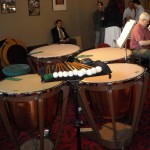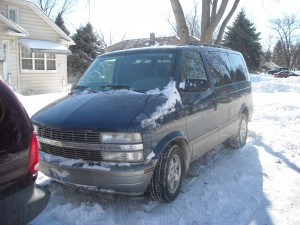My Instruments – Part Two
In my previous post, I talked about the Light Mark XI timpani, which I use as my primary instruments. In this post, I’ll talk about what I call my secondary instruments, which I use for church gigs and pops concerts, as well as for the times when there is a lot of hauling instruments and short turn-around times between jobs.
As I mentioned in the previous post, I was a bit spoiled during my tenure with the Oslo Philharmonic (1983 -1998) in that the orchestra was responsible for the storage and placement of the instruments that they owned. I had a large responsibility in addition to using them – I maintained them – ordering heads and changing them out as needed and keeping them in optimal condition. The rest was left to the orchestra.
All that changed when I left the orchestra to come back to the USA in the summer of 1998. All of a sudden, I was in a pool of many free-lance players, and if I was to do any free lance playing at all, there were two things I needed: instruments, and a means of transporting them. Transportation came first with the purchase of a 1993 GMC Safari, which was more than adequate for my needs. This was accomplished in September of 1998. Next, came the instruments. After consulting with some valued colleagues and with Steve Weiss Music, I was able to locate a pair of Yamaha 6000s – sizes 26″ and 29″.
Outside Instruments
Using borrowed instruments for the outside drums got a little old after a while, so it was decided that the time had come to start filling the gap with the purchase of outside drums. I decided to start with getting hold of a 31 or 32 inch drum – preferably of the same make – namely a Yamaha 6000. I had used my inside Yamahas in combination with Ludwig drums when I played with the former Savannah Symphony in 2002, as well as with the Des Moines Metro Opera during the 1999, 2000 and 2001 seasons. The sound was more than acceptable, but I could sense the difference, and I was on the lookout for instruments that were a better match. I had been taught (and had it reinforced by experience) that if one has purchased the inner pair of timpani, the next drum to purchase should be the 32 inch. This is because that particular instruments will cover the lower register much better in terms of a fuller tone and will cover the lower range much more adequately.
A 32 inch Yamaha 6000 came up for sale on the Internet in the late winter of 2004. It seems that a small college in the neighborhood of State College, PA was selling one that was in excellent condition, and needed to sell it quick. The price was about right, so I went alone this time to Pennsylvania, having rented a Chevy Venture minivan for the trip. I was able to make the trip pay for itself as I was invited to do a master class at Penn State for Dan Armstrong and his students. The return trip was uneventful, and now I had three drums – three down and one to go. Flash forward to June 2005. Yamaha wanted to unload the last of their 6000 series and had a 23″ timpano for sale. Since the warehouse in Grand Rapids was closing, I had the drum shipped to a local music dealer, where it was picked up. Up to this time, I had the original Yamaha/Remo heads on the lower three drums, and the newest addition came with the same type of head. I decided to change all four and see how they worked with Remo Renaissance heads. A set was ordered, and I mounted them just in time for the 2005 summer season of the Des Moines Metro Opera. The sound of the new heads made a huge difference, with the drums sounding very, very well during that summer season. They have been a great factor in my success in the free lance music scene ever since.
Moving the Instruments
Moving the instruments around from job to job requires a reliable vehicle. When I first returned to the States in the summer of 1998, all my wife and I had to drive was a 1989 Oldsmobile Cutlass Ciera. It was a good car, but there was no way it was going to hold timpani. I was most fortunate in getting hold of a used 1993 GMC Safari in late September of 1998. It was in excellent shape, and just the vehicle for the job at hand. It served me well until the late winter of 2002, when the transmission went. The vehicles that succeeded it were more or less adequate, but each of them had faults that rendered them less than perfect. The 1993 Pontiac had a faulty electrical system which I had to replace in the fall of 2002, and the 1993 Plymouth Voyager was too small for four drums, but adequate for three. In 2005, we were fortunate to get hold of a 1999 Dodge Grand Caravan with very low mileage and in excellent condition. For the next six years, this car served as our workhorse and drum hauler. Not only could I haul four timpani without a problem, I could haul my stool, stand, cases and other paraphernalia without a problem, but also all my household goods when I did the summer opera festival in Iowa each summer.
Since 2011, I have been using a 2005 Chevy Astro LT which is similar in many ways to my old Safari, but much better appointed. It is even roomier than the Dodge was, and is my “chariot of choice” today.
Loading in in straightforward: The 29 inch goes in first – right behind the driver’s seat. The 26 inch is next, behing the passenger seat. My music stand goes right behind the seats – between the drums and the seats. The 23 inch goes in behind the 26 inch and the 32 inch goes in last behind the 29 inch drum. There is space left for my stool and stick cases. My jobs usually involve traveling about twenty-five minutes to an hour one way from my house to the venue, although my summer trips to the DMMO in Indianola involve a six-hour drive one way. As the van is an LT, it is nice to be able to drive in some comfort.
Below is a video clip which I made some time ago and it features the Yamahas. It was made in 2012 out at the Des Moines Metro Opera Festival. Enjoy!
.



Recent Comments